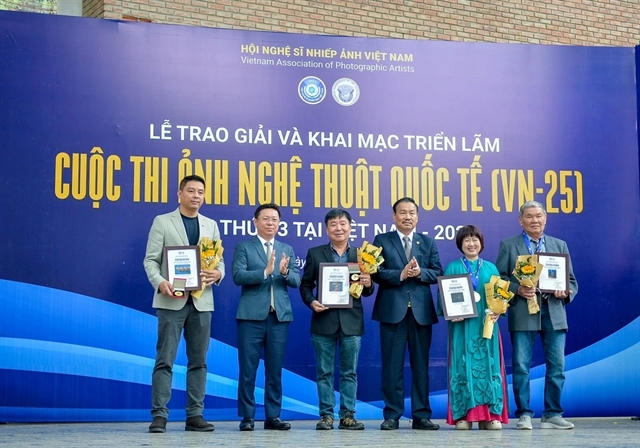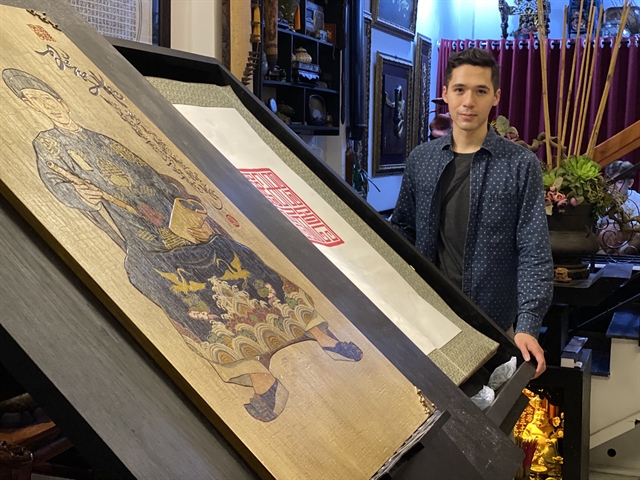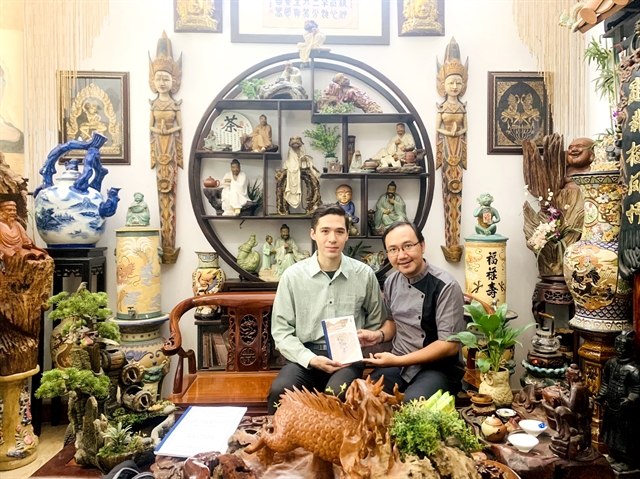 Life & Style
Life & Style

Richard Gessert, an American student, was drawn to the art of Vietnamese calligraphy from the very first time he saw it.

|
| Richard Gessert at Thăng Hoa Việt Thư Quán, a calligraphy centre in Hồ Chí Minh City. Photo courtesy of Richard Gessert |
Bảo Ngọc
Calligraphy, or the art of handwriting, allows the writer to convey their inner thoughts and feelings through their work, and one young man from the US is determined to spread the ancient craft.
Richard Gessert, an American student, was drawn to the art of Vietnamese calligraphy from the very first time he saw it.
He refers to the romanised form of Vietnamese calligraphy as a "unique" art form that he came across for the first time in 2010.
Calligraphy has a history in almost every country, though it often goes by a different name and takes on a few different guises.
The Vietnamese term for calligraphy is 'Thư Pháp', which literally translates to "the rule of writing".
'Thư' refers to the script used in calligraphy, and 'Pháp' refers to the guiding principles behind its creation.
"I first encountered romanised Vietnamese calligraphy (thư pháp chữ Quốc Ngữ) as a tourist in HCM City," Richard told Việt Nam News. "I found it unique at the time because it featured the Vietnamese Latin-letter alphabet," he said.
Gessert also mentioned his intense fascination with the craft and how he began studying it in the United States.
It was developed from Hán, or Chinese calligraphy, during the reign of the northern invaders.
Calligraphy in Việt Nam has evolved over the centuries to the point where it no longer merely refers to a set of guidelines for producing visually appealing writing; rather, it is now regarded as an art form in which each and every character must be rendered aesthetically pleasing.
This form of art is regarded as a significant part of Việt Nam's cultural heritage, and it has been a source of inspiration for not only many young Vietnamese but also people from other countries.
Later, the aspiring young calligrapher was able to travel to Việt Nam on a research grant to study with eminent calligraphers and learn more about the art's roots and techniques.
"During my time in Chicago, I met a local calligrapher (ông đồ) during a Tết celebration at a local Vietnamese Buddhist temple. Then, when I moved to HCM City, I have had the opportunity to meet local calligraphers such as Vũ Đăng Học, Võ Tuấn Xuân Thành, and Prof. Nguyễn Hiếu Tín from Tôn Đức Thắng University.
"Đăng Học has generously offered to teach me calligraphy, so I have begun taking lessons with him at his centre called Thăng Hoa Thư Việt Quán. Learning how calligraphy is created has helped me understand the art form as a practice with its own community in present-day Việt Nam."

|
| Richard in front of calligrapher Vũ Đăng Học's artwork. Học, according to the American calligrapher, was the one who introduced him to this art form. |

|
| Richard with Prof. Nguyễn Hiếu Tín from Tôn Đức Thắng University. The aspiring young calligrapher travelled to Việt Nam on a research grant to study with eminent calligraphers and learn more about the art's roots. |
Gessert said the more he learns about Vietnamese calligraphy, the more he appreciates it and realises how little attention it receives in Việt Nam.
He said: "One of the challenges has been learning how romanised calligraphy has been understudied.
"Despite how unique romanised Vietnamese calligraphy appears compared to other forms of calligraphy in the region, sometimes people regard Hán Nôm calligraphy more highly than its romanised counterpart.
"Still, Quốc Ngữ has been used as the standard Vietnamese writing system since the early-mid twentieth century. Literary movements from the 1930s, such as Tự Lực Văn Đoàn (Self-Reliant Literary Association) and Thơ Mới (New Poetry), were examples of how the intelligentsia at the time embraced Quốc Ngữ, so it is not a surprise that a poet such as Đông Hồ did as well.
"Part of my research deals with understanding the reception of romanised calligraphy in Vietnamese culture and society," he added.
Gessert believes that Việt Nam's calligraphy is distinctive in comparison to that of other countries.
For him, calligraphy is a medium through which the history and culture of Vietnam can be communicated.
"Compared to East Asian calligraphy such as in China, Korea, or Japan, romanised Vietnamese calligraphy stands out."
"Unlike other romanised scripts in East Asia, such as Chinese pinyin, Korean romaja, or Japanese romaji, Quốc Ngữ is the standard modern writing system in Việt Nam. Chữ Hán is primarily a historical script in modern-day in the country, and only a small percentage of people today can read Chữ Nôm.
"Besides Quốc Ngữ, the modern Vietnamese writing system does not use alternative scripts as neighbouring countries do. Furthermore, Vietnamese calligraphy utilises Vietnamese literature, primarily poetry. For example, in Quy Nhơn, there is a poetry garden where the poetry of Hàn Mặc Tử is displayed as works of calligraphy.
"I think Việt Nam has rich literary traditions, and that comes through in calligraphy."
When asked about his plans for the future, Gessert said he hopes to become more well-versed in Vietnamese culture to share it with others better.
"I am very much interested in Vietnamese cultural history and visual culture broadly. In addition to subjects such as language studies and Vietnamese food history, I maintain an interest in modern design, architecture, fashion, and mass culture.
"I plan on building upon my experience in Việt Nam, and I am interested in pursuing a career in academia and the arts to ensure I can share my growing knowledge about Việt Nam," he said. VNS